Editorial
French Open: Kerber’s Defeat Proves That Roland Garros’ Seeds Should Be Determined As At Wimbledon
Published
7 years agoon

Angelique Kerber (zimbio.com)
We need rankings and seeds determined according to the different surfaces, especially red clay and grass. Otherwise the draws will always be wobbly. In the women’s tournament, Kerber at No. 1 and Pliskova at No. 2 make very little sense, just like Nadal at No. 4 in the men’s event.
PARIS – If we forget about ethical issues for a moment, it is very clear that women’s tennis desperately needs Maria Sharapova. Along with comeback girl Petra Kvitova, the Russian superstar could give the top of the women’s game a decent amount of credibility that the tour is currently lacking due to the crisis of world No. 1 Angelique Kerber. This year the German has lost seven times in the first round, including her inexplicable 6-2, 6-2 defeat to Ekaterina Makarova at the French Open.
Last year Kerber won two Slam titles and competed in both the Wimbledon and Olympic finals, but so far this season she has been a shadow of herself. Her ability to fight and grind out matches has been completely missing. The No. 2 seed Karolina Pliskova could probably do a little better than the German in this tournament, even if the Czech has never been a clay court specialist. At this point, the French Open tournament organizers should look into the possibility to determine seeds based on the players’ record on the red clay, exactly like the All England Club does for Wimbledon.
Lewis Carroll, the author of “Alice in Wonderland”, first promoted the idea of having seeded players in order to avoid that the best players would face each other in the first few rounds.
The reason why the ATP and WTA have decided to come up with a special grass court ranking system that would determine the Wimbledon seeds is that there are only a few tournaments a year on that particular surface.
Compared to the last couple of decades, the number of clay court tournaments has decreased as well, hence Rafa Nadal’s complaint about how short the clay court season has become. Most of the women’s players today have the same game: Big and power ground-strokes with very little creativity. Talented shot-makers such as Schiavone or Vinci have become very rare on the women’s tour.
Kerber, Pliskova, Konta, Cibulkova, Radwanska, Venus Williams and Wozniacki are all not as good on clay as they are on hard courts. At the moment, the best clay courters in the world are probably Halep, Svitolina and last year’s French Open champ Muguruza. If we had a system that determines the seeds according to the surface, those three players would probably be the first three seeds.
We also face the same issue in the men’s event. In spite of the fact that he is the overwhelming favorite to win the title, Nadal is only seeded at No. 4, which makes very little sense. Another non-sense is the No. 5 seed assigned to Milos Raonic, while Dominic Thiem, who has this year enjoyed very good success on the dirt, is only seeded No. 6.
(Article translation provided by T&L Global – Translation & Language Solutions – www.t-lglobal.com )
You may like

In my view, Stefanos Tsitsipas is right up there among the most appealing players to watch in professional tennis. His game is as complete as anyone in the sport. His first serve may well be a singularly underrated weapon. His forehand must be regarded as one of the five best in men’s tennis. His transition game is outstanding. Over the years, his volley has improved markedly. His court coverage is extraordinary. And while the skeptics will always be critical of his one-handed backhand as a wing of vulnerability that does not stack up well against the game’s great two-handed backhands belonging to the likes of Novak Djokovic, Jannik Sinner and Carlos Alcaraz, the fact remains that the Tsitsipas topspin backhand is a majestic stroke and it is particularly effective on clay.
Count me in as someone who fell into the trap of selling Tsitsipas short over the past year. After reaching his second Grand Slam final at the Australian Open at the start of 2023, he won only one tournament all year and his best showing at a major was a quarterfinal appearance at Roland Garros. This year, the Greek stylist was desultory of his lofty standards, winning only 11 of 17 matches across the season on his way to Monte Carlo. Even his staunchest supporters were becoming increasingly alarmed about the state of his game and the apparent darkness of his outlook.
But what a difference a single week can make in allowing a top player to start believing again and reinvent himself after a long and debilitating slump. Tsitsipas collected his third singles title at the Rolex Monte-Carlo Masters on the red clay that suits him so well, defeating Casper Ruud 6-1, 6-4 in the final, rising from No. 12 in the world back into his old top ten residence at No. 7. That is where he belongs, and the feeling grows that the 25-year-old will now prove his critics wrong by soon taking the next step up the ladder and returning to the top five.
The showdown with Ruud did not live up entirely to expectations. While Tsitsipas has been in two Grand Slam tournament finals including the French Open title round meeting against Djokovic in 2021 which he lost in five sets, Ruud had been to three major finals including the last two at Roland Garros along with the U.S. Open of 2022. Ruud lost to Alcaraz in that U.S. Open duel and was beaten by Rafael Nadal and Djokovic in Paris.
It must be mentioned that while Tsitsipas has been victorious at the ATP Finals (in 2019) and now has triumphed thrice at Masters 1000 events, all ten of Ruud’s ATP Tour tournament victories have been at 250 level events. But he did reach the final round at the ATP Finals in Turin at the end of 2022. Meanwhile, Ruud made it up to No. 2 in the world after the U.S. Open in 2022 and Tsitsipas has climbed as high as No. 3 in addition to finishing two years in a row (2021 and 2022) at No. 4.
In two of their three previous career clashes, Ruud had defeated Tsitsipas. On paper, their final round skirmish in Monte Carlo seemed certain to be very close. But on court it was a different story. Perhaps inspired by his history on the fabled stage in Monte Carlo, Tsitsipas was in exemplary form from the outset yet Ruud was apprehensive. The Norwegian has an outstanding forehand in his own right, but Tsitsipas was beating him badly to the punch off that side.
After Ruud held in the opening game, Tsitsipas swept six games in a row to seal the opening set swiftly and emphatically. He mixed in the serve-and-volley skillfully and selectively to exploit Ruud’s deep return positioning. He took control off his forehand and got to the net on his own terms. And his one-handed backhand was decidedly better than the Ruud two-hander. Ruud has improved over the last year off that side but he could not stay with Tsitsipas on this occasion, nor could he prevent Tsitsipas from stepping around and taking complete control with his inside-out and inside-in forehands.
In that opening set, Tsitsipas started his six game run with a love hold, broke Ruud at 30 in the third game and then fended off three break points against him to reach 3-1. Tsitsipas managed another break for 4-1, moved to 5-1 on his fourth game point and then sealed the set 6-1 on a double fault from a beleaguered Ruud.
The second set was tighter but Tsitsipas refused to relinquish his authority. Ruud had a break point in the opening game that Tsitsipas erased with a service winner out wide to the backhand. He held on but soon found himself tested again, saving another break point on his way to 2-1 as Ruud bungled a second serve return off the forehand. Serving at break point in the sixth game, Ruud rescued himself with an audacious serve-volley, making a stupendous pickup on the backhand finesse half volley that landed short in the court and coaxed a mistake from Tsitsipas.
Ruud made it safely to 3-3 and then went full force after a service break in the seventh game that might have altered the complexion of the match. Tsitsipas led 40-0 in that crucial seventh game but Ruud rallied to reach break point three times. Tsitsipas raised his game on all of them. He saved the first one by pulling Ruud off the court to set up a forehand winner, wiped away the second with a backhand volley winner, and serve-volleyed his way out of the third. After six deuces, Tsitsipas moved to 4-3 with a clean winner off the forehand.
Both players knew that was essentially the match. Although Ruud gamely held at love for 4-4, Tsitsipas was unstoppable, taking eight of the last ten points to complete his 6-1, 6-4 victory and reignite his career. He saved all eight break points he faced and won 68% of his second serve points. Conversely, Ruud was able to erase only four of the eight break points he confronted, and he took just 37% of his second serve points.
Embed from Getty ImagesThe semifinal contests were far more intriguing on both halves of the draw. Tsitsipas opened against Jannik Sinner. The No. 2 seed from Italy had won 25 of 26 matches this season and three of the four tournaments he had played, including his first major at the Australian Open and the recent Miami Open Masters 1000 event. Sinner was slightly off his game in the early stages as Tsitsipas outplayed him from the backcourt. One break in the third game of the first set was all Tsitsipas needed. Sinner double faulted at 30-40 to lose his serve and Tsitsipas held all the way through to win it 6-4. Sinner surged to 3-0 in the second set and then withstood a severe challenge from Tsitsipas with the score 5-3 in the Italian’s favor. Tsitsipas had no fewer than five break points but Sinner was fiercely determined. After nearly 13 minutes, he held on to take the set 6-3.
Sinner swiftly established a 3-1 lead in the third and final set. He reached break point in the fifth game but Tsitsipas aced him. Soon Sinner was at break point for the second time in that game. Tsitsipas served a double fault which landed almost three inches long. But, astoundingly, there was no call—and no overrule from the umpire. Sinner lost that point on an errant forehand passing shot and Tsitsipas held on to stay within one break of his adversary.
In the following game, Sinner started stretching out his leg between points. He seemed to be saying later it was cramping that was causing his consternation. Sinner held for 4-2 but looked somewhat lame in the following game when Tsitsipas easily held at love. At the changeover, the trainers rubbed Sinner’s leg, and then he fought with quiet intensity to hold in the eighth game. Despite having difficulty moving to his right for the forehand on the stretch, Sinner had a game point but, after four deuces, he was broken and the set was locked at 4-4.
Tsitsipas knew he had the ailing Sinner where he wanted him now. He closed out this stirring account by taking eight of the last ten points, prevailing 6-4, 3-6, 6-4 on a run of four straight games. Tsitsipas beat Sinner with some spectacular tennis, but he was a fortunate fellow that the double fault in the fifth game of that final set was not called. From two breaks down, Tsitsipas would surely have lost that battle.
Meanwhile, Ruud took on the 2013 and 2015 Monte Carlo victor Djokovic in the second semifinal. Having skipped Miami after losing early at Indian Wells to the Italian Luca Nardi, Djokovic sorely needed to restore some of his confidence and get some much needed match play on the clay after playing only 11 matches all year long. This was only his third tournament of 2024.
The 36-year-old made a good run to the penultimate round despite being well below the top of his game for most of the tournament. He did start well against the Russian Roman Safiullin in his opening match. Djokovic took apart his 26-year-old adversary 6-1, 6-2 with a nearly impeccable display of consistency from the baseline and precision on serve. So dominant was Djokovic that he even had break points in all three games that Safiullin won.
Next on his agenda was a rematch with the Italian Lorenzo Musetti, the world No. 24. A year ago in Monte Carlo, Musetti toppled Djokovic. This time around, Djokovic turned the tables on the 22-year-old after trailing 1-3 and nearly going two breaks down in the first set. Moreover, Musetti served at 4-3, 40-0 but Djokovic broke him there and never looked back. He took that encounter 7-5, 6-3 to move into the quarterfinals.
Waiting for him in that round was the Alex de Minaur. The Australian had upended Djokovic in the United Cup team competition at the start of the season on hard courts. On the Monte Carlo clay, Djokovic retaliated in a bizarre contest. The first set came down to one break at the end for Djokovic but there were six consecutive service breaks at one stage in the second set before de Minaur held for 4-4. Djokovic took control from there with a no nonsense attitude, winning two games in a row and eight of nine points with unblemished play to finish off a 7-5, 6-4 win.
Taking on Ruud in the semifinals, Djokovic commenced the contest in the same listless and subdued state he had played his opening sets against Musetti and de Minaur. His energy level seemed well short of normal. Ruud took full advantage and bolted to a 4-1, two break lead in the first set predominantly on the strength of his stellar forehand. Djokovic played better in the latter stages of the set and got one of the breaks back, but that was not enough to salvage it.
In the second set, Djokovic found his range and played perhaps his finest set of the tournament despite missing 16 of 21 first serves. That statistic did not matter, however, because Ruud was doing no harm with second serve returns and Djokovic was so masterful from the baseline. Djokovic dropped only five points in four service games. Ruud, meanwhile, was much less solid off the backhand and his serve deserted him. The 25-year-old served three double faults at 1-4 in the second set and soon Djokovic wrapped it up 6-1.
But Ruud admirably reasserted himself, surging to 4-1 in the third. Djokovic had a 30-0 lead when he served at 0-1 but a double fault there was costly and a Ruud backhand down the line winner at 30-30 led to the break. Djokovic came roaring back to win three games in a row in a sparkling sequence highlighted by a vintage backhand down the line winner that gave him a 0-40 lead in the seventh game.
Forthrightly, Ruud weathered the storm. He held comfortably for 5-4 and then in the tenth game built a 0-40, triple match point lead. Djokovic promptly served an ace down the T and played a perfect serve-and-volley point to make it 30-40. But, after missing his first serve, he bounced the ball 19 times before releasing the second delivery. He double faulted wildly long and Ruud advanced 6-4, 1-6, 6-4. Djokovic won 84 points in the match, which was eleven more than Ruud. But the Norwegian deserved his victory. He was better down the stretch when it mattered the most.
Djokovic played his semifinal knowing that Tsitsipas had toppled Sinner. The Serbian has defeated Tsitsipas ten consecutive times since 2019 to take an 11-2 lead in their rivalry. It surely must have crossed his mind that if he could beat Ruud he would have a very good chance to win the tournament over a player he has ousted so many times in big matches. Perhaps that was in the back of his mind as he contested his match with the Norwegian.
Nonetheless, Djokovic made some significant progress by playing four matches and recovering a measure of self conviction in Monte Carlo. I fully expect him to take his game to a higher level in Madrid and Rome, particularly the latter. He will be ready to peak at Roland Garros and make the strongest possible bid for a third title in four years and a fourth crown overall at the clay court shrine.
As for Stefanos Tsitsipas, he gave himself an immeasurable boost by winning the title in Monte Carlo. His clay court results year in and year out are always good and sometimes great. He has silenced his critics sweepingly by capturing the first of the Masters 1000 crowns on his favorite surface. Tsitsipas has reminded himself of how remarkable he can be when his mind is uncluttered, his heart is in the right place and his priorities clear. Moreover, Tsitsipas has reaffirmed for us that he can play this game with a verve and spontaneity few in his profession can match.
Editorial
Statistical Deep Dive: Sinner At Rotterdam One Year Later
Jannik Sinner’s Rotterdam title compared with his run to the final last year.
Published
2 months agoon
04/03/2024
By Federico Bertelli
Let’s delve into Jannik Sinner’s triumphant journey at the ABN Amro Open and compare it with his 2023 campaign. Service and down-the-line backhands were the keys to victory.
Harder, Better, Faster, Stronger. This is the version of Sinner that his opponents tasted, and it’s also the title of a Daft Punk song; the clip particularly reflects what the rest of the ATP circuit has been thinking about Jannik for some months now: an android emerging after a heavy upgrade. Jokes aside, as the sunshine double is about to start, we thought it wise to rewind and closely examine Sinner’s recent victories.
The focus of our analysis is the Rotterdam tournament: Sinner’s performance was spotless, a feat not seen since 2001 when Lleyton Hewitt, after his victory at Flushing Meadows over Pete Sampras, managed to repeat his success in Tokyo. If the Italian were to win next week under the California sun as well, he would be the first in ATP tennis history to win two consecutive ATP tournaments after the first Slam. But before we dive into the action of the Indian Wells, let’s scratch the surface of Sinner’s victory in the Netherlands a bit. The comparison is plausible as the Italian reached the final in both editions, playing 5 matches in each case.
Draw: The 2024 run was undoubtedly smoother compared to 2023, both on average and in absolute terms. In 2023, the average ranking of Sinner’s opponents increased significantly, from 50.6 in 2023 to 97 in 2024. This means that, in general, we can assume that the journey, at least on paper, was easier. Also, in absolute terms – considering the lowest ranking of an opponent faced – there was a notable difference. In 2023, the insurmountable obstacle was the Russian Medvedev, then the blue’s nemesis and number 3 in the rankings. In 2024, it was a more approachable De Minaur – number 11 in the ATP ranking – against whom the H2Hs have also always been in favour of Jannik.
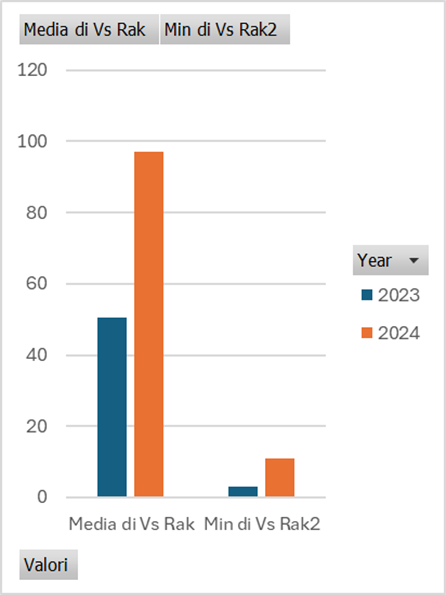
Break Points: One aspect frequently discussed about Sinner in the last 12 months is his overall growth in all areas: technical, physical, and mental. However, it’s not news that Jannik is mentally tough. Surely, Sinner will continue to tirelessly work on this aspect, as he has always stated, but his starting base has always been enviable. And the results are there for everyone to see. Despite facing a number of break points in the tournament equal to 20 in both 2023 and 2024 – which perhaps was unexpected given the more modest caliber of opponents – the Italian’s response was undeniable. An 80% break point save rate, compared to 65% in 2023 and against an ATP tour average of 61%. (Note: The tour average refers to the average of the last 52 weeks of players who have competed in ATP level tournaments). This figure, among other things, underscores Jannik’s solidity, already above average in 2023.

Service – Overall Statistics: Another aspect that has been frequently discussed is Jannik’s improvement in his service game; indeed, the data speaks for itself. Both in terms of the percentage of first serves in play and in terms of effectiveness in converting such a play situation into a point, Sinner has significantly elevated his game. Working on the percentage of first serves in play was the number one priority to improve the Italian’s game performance, and the efforts of Vagnozzi, Cahill & co. have paid off handsomely. In 2023 in Rotterdam, the percentage of first serves in play was 57%, in line with the general performances recorded by Sinner up to that point. Considering that the ATP tour average was 62%, it’s clear this was an aspect still needing improvement until last year. However, the conversion rate from good became excellent. In 2023 in Rotterdam, the conversion rate of points on the first serve stood at 74%, a figure above the tour average, which is at 72%. In 2024, however, we witnessed a further leap forward, reaching the 80% threshold.
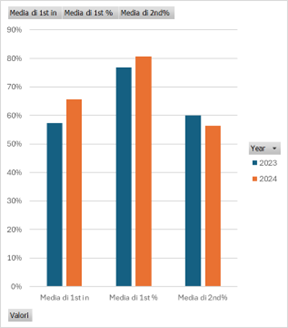
To understand how high this figure is, just look at the leaderboard rankings of the last 52 weeks. In terms of first serves converted into points, 80% is the threshold of absolute excellence. Consider that the two most impressive serving machines ever seen on a tennis court, Karlovic and Isner, had career averages of 83% and 80%, respectively.
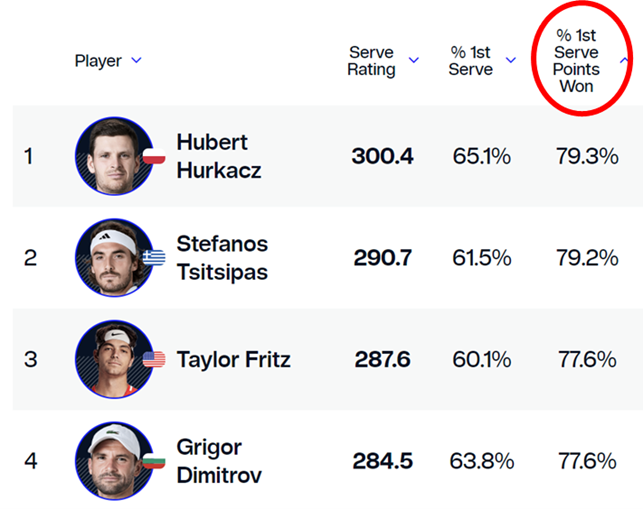
Finally, a somewhat surprising data point is the success performance on the second serve. The Italian won 60% of the points on his second serve in 2023, while in 2024, “only” 56%. This rate is evidently more than sufficient to win matches and tournaments, but in 2023, it was not a problem at all, on the contrary.
Delving further into detail and referring to more detailed analyses (for the metrics used, we also refer to the general description found here), the analysis is further enriched. The data reported are the result of TennisViz processing, on data owned by Tennis Data Innovations (TDI).
Service – Detailed Data: The service performance, in terms of precision and reliability of the shot under pressure, has improved from all perspectives. Among the various metrics available, there are some of interest. Starting with the accuracy on the first serve, i.e., the distance with which the serve is placed from the service lines, measured in cm. Referencing a post from the X Tennis Insights account, we have an overview.
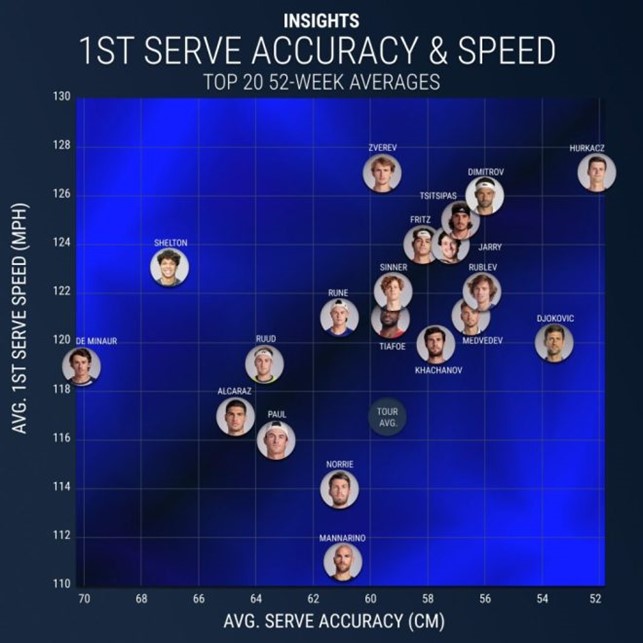
In Rotterdam in 2023, Sinner executed this shot with an accuracy of 57 cm, better than what was measured over the course of the year. But in 2024, this figure impressively dropped to a notable 52 cm, in line with that of Hurkacz. We’ll spare you the statistical details, but the result (highly debatable, given the small sample size) is as follows.
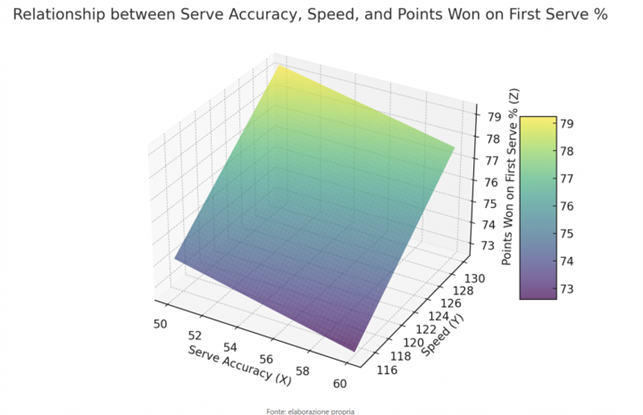

Of course, there are many other variables that explain the yield on the first serve, but the inverse correlation between serve speed and precision is not bad, and generally leads us to say that serving at 125 mph with an accuracy of 52 cm, combined with an average quality in return shots, guarantees an untouchable performance of 80% of points won on the first serve. If the quality is that of Sinner’s serving machine, even less will suffice.
Continuing with the quality of the service shown by Sinner, another data point that deserves further exploration is that of unreturned serves, where the opponent fails to return the serve back into play. Here too, Jannik performed exceptionally well, with aces and opponents’ missed returns bringing home an impressive 40% in 2023 and an exceptional 42% in 2024. Remember, in tennis, variations of 1% can make the difference between a solid top ten player and a Grand Slam title winner. To put it in perspective, the ATP average is 38%.
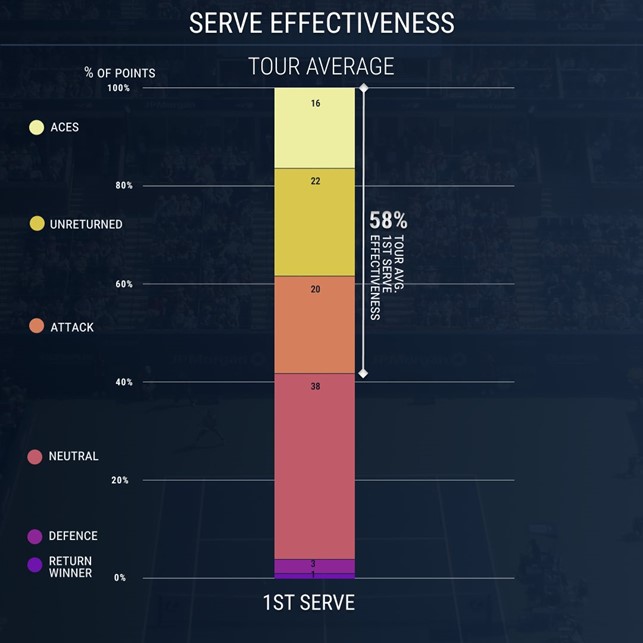
Finally, to conclude the chapter on the serve, one last piece of data, which we’ve kept in reserve for the most deserving who have persisted in reading up to this point; do you know what the percentage of first serve balls on break points was in 2023? And in 2024? Well, we’ll present it to you in a table, and we’ll add nothing more:

In 2023, when serving on break points, the first serve landed much less than usual in crucial moments. In 2024, however, the Italian did not lose his composure at all, serving as if it were any other point… not bad at all.
Performance in rallies: in this case, we rely on [metrics developed by TDI and TennisViz, which obviously carry the ATP brand](https://www.atptour.com/en/news/insights-introduction); (bonus: if you happen to watch a match on ATP TV, these advanced metrics are just a click away, in the stats section of the App).

It’s notable how Jannik has leveled up both in his ability to convert points where he had the advantage (conversion score) and in managing to seize the initiative from opponents when they were in a favorable position during the rally (steal score). Lastly, the final data point: from the baseline, with the current form of Jannik, it’s tough to come out on top, and if we consider his aptitude for turning defense into offense, the puzzle for his opponents is almost unsolvable. Indeed, this explains the overwhelming 56% of points won from the baseline, significantly above the ATP average. This data also finds an explanation in a significant tactical adjustment, the more pronounced use of the down-the-line backhand variation. The backhand crosscourt is already a comfort zone for Sinner, which he can comfortably use to extract points, like a boxer working his opponent with jabs; if we add that now Sinner is also able to find the down-the-line solution at the right moment, again, it spells trouble for his opponents. In 2023, Sinner hit 19.5% of his backhands down the line, while in 2024 this percentage rose to 31.4% in the Rotterdam tournament. A change that helped him tip the scale further in his favor in baseline battles.
Comments
Djokovic Reminds Everyone In Turn And Around The World Who Is The Tennis Boss
Published
5 months agoon
21/11/2023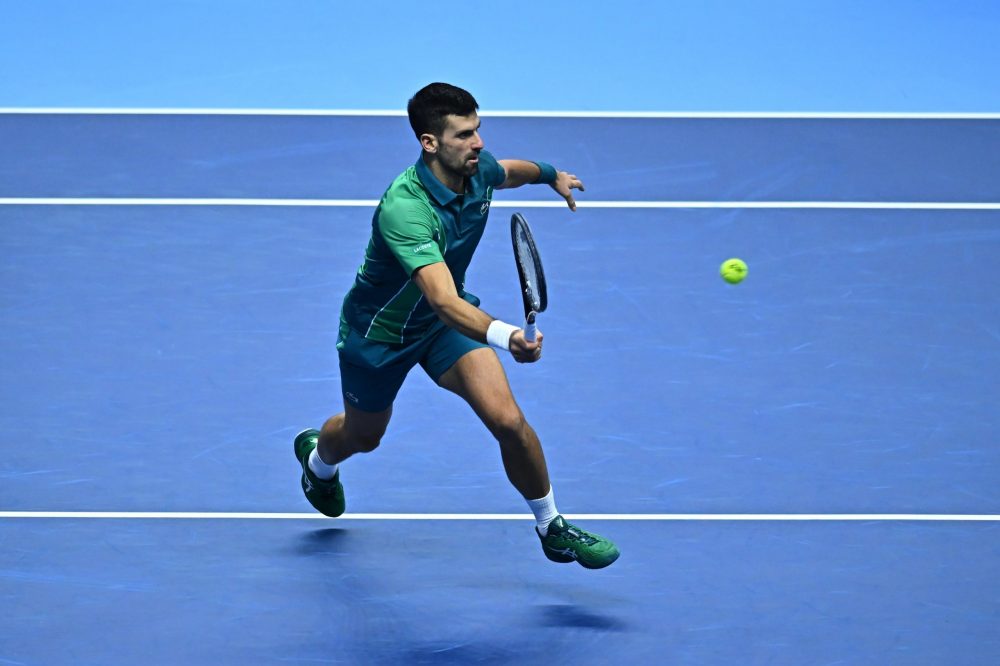
The season ending Nitto ATP Finals is a singularly sparkling showcase for the top eight players in the world, a tournament that ends the season in men’s tennis on a high note with so many sparkling matchups, and a celebration of how stirring a spectacle the indoor game can be. With two round robin groups comprised of four players each leading into straightforward, single elimination semifinals and final, there is an intrigue surrounding the festivities at this tournament that does not even remotely resemble any other event.
This time around in Turin, the round robin produced some majestic tennis, and the keynote performer was none other than the swashbuckling Italian Jannik Sinner. He kept Italian hopes exceedingly high all week long, taking all three matches he played in the round robin before eclipsing Daniil Medvedev for the third time in a row to claim a place in the most significant final of his career. Among those he defeated in round robin play was none other than Novak Djokovic. Sinner was riding high, raising expectations all across his nation, and making everyone stand up and pay close attention to him and his exploits.
But what too many learned observers failed to recognize was that Djokovic is the ultimate big match player. He can turn himself into an entirely different player when he has a mission on his mind and whenever he feels the need to redefine himself to his fellow players and the tennis world at large. Moreover, after winning two of his three round robin clashes but being pushed to three sets in all of them, he was dissatisfied with his level of play and determined to prove to himself that he could win a record breaking seventh ATP Finals crown and perform at the loftiest heights when the stakes were greatest and the pressure was on.
Embed from Getty ImagesThe tennis that Djokovic unleashed over the weekend in Turin across the semifinal and final may very well have surpassed anything he put on display in winning three of the four majors in 2023. It was almost inarguably the best he has summoned all year long because he clearly wanted to conclude the 2023 tournament campaign with a flourish and use his triumphant run in Italy to roar into the year ahead with force, conviction, persuasion and the utmost of confidence.
Given the opportunity to avenge his loss to Sinner five days after they had met in the round robin, Djokovic was well aware that he had been too conservative in that initial appointment. Both players won 109 points in that memorable round robin duel, but it was Sinner who had been unmistakably bolder on the biggest points, particularly down the homestretch. Djokovic recognized swiftly that he would need to make amends if he got a second chance against Sinner, and he did just that.
From the outset in the final, Djokovic was outhitting Sinner from the backcourt, serving with uncanny precision and purpose, taking matters entirely into his own hands, and playing the match on his own terms. He was setting the tactical agenda.
Above all else, the ease with which Djokovic was holding serve was creating a tension in Sinner that was almost tangible. The first game was thematic. Djokovic held at love, releasing a pair of aces in the process. On his way to 2-1, the Serbian produced two more aces and held at 15. Sinner established a 40-15 lead in the fourth game but a serve-and-volley combination did not do the job. Djokovic beat him with a topspin lob winner before the 22-year-old lost the next two points with errant forehands, although he should have challenged the second one because his forehand clipped the baseline.
At break point down, Sinner overcooked another forehand, sending it wide, allowing Djokovic the luxury of a 3-1 lead. Djokovic surged to 4-1 at the cost of only one point and then advanced to 5-2 at love with an ace, a service winner and two more unreturned serves. Serving for the set at 5-3, Djokovic did not allow Sinner a point as he closed out the set 6-3 very commandingly. In five service games, he won 20 of 22 points, connected with 73% of his first serves, and aced Sinner seven times. He made two unforced errors over the course of nine games.
Embed from Getty ImagesThe 36-year-old built on his momentum by breaking Sinner at love to start the second set before holding at love to reach 2-0, sending out his eighth and ninth aces in that game. By the time a masterful Djokovic reached 0-30 in the third game, he had won 14 consecutive points and was threatening to break the contest wide open. Later in that third game he had three break points but Sinner erased the first with an unanswerable 115 MPH second serve down the T. Djokovic had a golden opportunity on the second but his forehand down the line passing shot which had Sinner beaten cold bounded off the net cord and landed wide. He had a third break point that Sinner saved with an ace. After three deuces, Sinner tenuously held on.
Djokovic was unswayed, holding at love for 3-1 with three straight aces followed by a service winner. But he was given his sternest test yet in the sixth game, falling behind 15-40. And yet a service winner out wide saved the first break point and another effective first serve coaxed a backhand return error from Sinner, enabling Djokovic to make it back to deuce. He took the next two points confidently for a 4-2 lead.
Once more, Djokovic made a concerted effort to get the insurance break. With Sinner serving in the seventh game, there were eight deuces and Sinner did not hold until his seventh game point after Djokovic had two break points that he squandered with a sliced backhand error and a miscalculation on a Sinner forehand that landed on the sideline and left the Serbian unprepared. Sinner secured that arduous hold with an ace, leaving Djokovic apprehensive about another missed chance.
Serving with new balls at 4-3, Djokovic trailed 0-30, but eventually held from deuce, finishing off that somewhat shaky hold with his 13th ace. Now Sinner was serving to stay in the match in the ninth game and, despite an ace for 30-30, he was broken at 30 on his lone double fault of the match. Djokovic emerged victorious 6-3, 6-3. His triumph can be attributed to two primary virtues: the quality of his first and second serves, and his blend of firepower and consistency from the backcourt. He was hitting his forehand considerably harder than Sinner, which is no mean feat. He won 38 of 46 points on serve altogether, most notably 29 of 32 on his first serve. And he never allowed Sinner to get comfortable from the backcourt, keeping the Italian at bay with pace and persistence off both sides.
Djokovic was no less dazzling in his dismantling of Alcaraz in the penultimate round. Every time they had met prior to this collision, Djokovic and Alcaraz had played matches that would not be classified as one-sided. Not one of their four previous duels had ended in straight sets. Alcaraz took their first contest in a final set tie-break on clay in Madrid 18 months ago. The Serbian and the Spaniard split two spectacular sets at Roland Garros this year in the semifinals before Djokovic prevailed 6-3, 5-7, 6-1, 6-1. Alcaraz had started cramping late in the second set.
In the Wimbledon final back in July, Alcaraz succeeded in five sets and then they did battle in the final of Cincinnati with Djokovic saving a match point in the second set tie-break before pulling out a gratifying victory in a third set tie-break. That spellbinding battle lasted nearly four hours.
Most members of the tennis cognoscenti were expecting another razor thin margin between the two best players in the world at Turin, but for the first time Djokovic defeated Alcaraz handily on the fast indoor hard court. It did not look like a romp in the early stages. Djokovic was down 15-40 in the opening game when Alcaraz drove a two-hander wide off the net cord. Djokovic’s 116 MPH second serve down the T put him in charge of the next point and Alcaraz missed his second shot off the forehand. A service winner and an ace took Djokovic out of danger and into a 1-0 lead.
But Alcaraz was serving up a storm. He made 14 first serves in a row and took 12 of 16 points on his delivery en route to 3-3. Djokovic had worked his way out of another difficult service game at 2-2 that went to two deuces as Alcaraz blasted away freely off the ground. But the 20-year-old Spaniard lost his range off the backhand in the eighth game and Djokovic broke him for a 5-3 lead. The Serbian then held at love with an ace out wide to seal the set 6-3.
Djokovic was pummeling away at Alcaraz’s backhand and keeping the Spaniard ill at ease and off balance. He broke for 2-1 in the second set, held easily for 3-1 and nearly gained another break in the fifth game. Alcaraz’s saved a break point and then found renewed inspiration when Djokovic served in the sixth game. Three rallies in that game lasted between 20 and 24 strokes. The Spaniard showed off his astounding speed and shotmaking versatility. At 15-15, Djokovic had Alcaraz on a string, moving him from corner to corner, controlling the rally ruthlessly. But Alcaraz somehow recovered, shifted from defense to offense and stunned the approving audience and his opponent with a forehand winner. He advanced to 15-40 with a forehand volley winner down the line.
Clearly the Spaniard believed he was about to break back and change the color of the contest. But Djokovic had other notions. A service winner down the T took him to 30-40. Now he had to defend steadfastly, but he did just that. On the 23rd shot of a fierce exchange, he angled a forehand crosscourt passing shot into the clear. From deuce he put away a forehand swing volley and then hit a service winner to reach 4-2. Djokovic was not complacent. He went full force after another service break in the seventh game and achieved it. After a 24 stroke exchange, he elicited a forehand error from the Spaniard to reach 5-2, and then easily served it out in the following game to finish off a satisfying 6-3, 6-2 victory over his chief rival all year in the battle for No. 1. Despite getting 84% of his first serves in and serving ten aces, Alcaraz was trounced by a top of the line Djokovic.
Embed from Getty ImagesThe Djokovic who toppled Alcaraz and Sinner was not playing the same brand of tennis in the round robin stage of the tournament in Turin. He had come into the event knowing he needed only one round robin victory to seal an eighth year-end No. 1 world ranking. That was his overriding goal. Pete Sampras concluded six consecutive (and total) years at No. 1. Roger Federer, Rafael Nadal and Jimmy Connors all ended five years at the top. Djokovic was determined to separate himself even more from those luminaries in this department, and he was well aware that he could add to his record for time spent at the top of the rankings to 400 weeks following Turin. Federer is in second place at 310 weeks.
So Djokovic took great pride in his dual achievement of eight year end finishes at No. 1 as well as 400 weeks. He secured that honor by taking his opening round robin match over Holger Rune 7-6 (4), 6-7 (1), 6-3. He was far from his zenith against the 20-year-old Dane. He did play a disciplined opening set tie-break but the second set tie-break was dismal from Djokovic’s end of the court. Even with Rune struggling physically in the final set and seemingly spent, Djokovic was below par but from 2-2 he took three games in a row. At 5-3 he held at love to close out the account.
The next day Djokovic was honored by the ATP with an on court ceremony for his No. 1 accomplishment. He returned the following evening to face Sinner, who had already easily dismissed Stefanos Tsitsipas in straight sets. Djokovic played good but not great tennis in this match, while Sinner was feeding off the crowd, performing magnificently. At 4-5, 15-30 in the first set, Sinner was fortunate when Djokovic inexplicably attempted a sliced backhand when he could have driven that shot. He missed it long. In the next game, Djokovic led 40-0 but Sinner swept three points in a row. At deuce, Djokovic double faulted and Sinner took the next point with calculated aggression. The Italian had the break and closed out the set unhesitatingly. Djokovic was twice down a mini-break in the second set tie-break but he rallied to win it seven points to five.
Sinner broke Djokovic to lead 4-2 in the third set but the Serbian retaliated in the following game. It all came down to a tie-break and Sinner was unstoppable. He won the first five points and pulled away to defeat Djokovic for the first time in four career appointments despite 20 aces from the Serbian. Sinner won 7-5, 6-7 (5), 7-6 (2).
Matters got complicated in that group. Tsitsipas retired with a back injury after trailing 2-1 in the first set against Rune. He was replaced by Hubert Hurkacz. Djokovic recouped from his loss to Sinner and beat the big serving Polish player 7-6 (1), 4-6, 6-1. Hurkacz did not miss a first serve in the tie-break but Djokovic was tremendous on his returns. The only point he lost was on his own serve at 6-0. But Hurkacz broke Djokovic once in the second set and was unyielding on his delivery. Not until the third set did Hurkacz’s level recede. His first serve percentage dropped to 45% with only ten first serves landing in the box. Seven of those ten were aces. He had 24 for the match.
Djokovic finished round robin play with a 2-1 record but only a 5-4 winning record in sets. That meant Rune could join Sinner in the semifinals from the Green Group if he beat the Italian that evening. Djokovic’s fate was in Sinner’s hands. Some wondered if Sinner might want to spare himself a potential rematch with Djokovic in the final by deliberately losing to Rune. But they failed to recognize that Sinner is a professional through and through. He was not going to give anything less than his best. He has a lot of integrity.
Sinner crushed Rune in the first set but dropped a tight second set. His back seemed to be bothering him. But he battled on gallantly in the third set and fended off a break point against him at 3-4. A body serve from the Italian drew an errant down the line backhand return from the Dane. Sinner came through 6-2, 5-7, 6-4 and saved Djokovic from missing out on the semifinals. Sinner finished first in the Green Group and Djokovic second.
Embed from Getty ImagesIn the Red Group, Daniil Medvedev had won his first two matches over Andrey Rublev and Sascha Zverev, prevailing in straight sets both times. His semifinal place was assured. But the other semifinalist from that group was up in the air. Alcaraz had lost a hard fought and well played encounter against Zverev 6-7 (3), 6-3, 6-4. It was perhaps Zverev’s best performance of the 2023 season. But then he lost to Medvedev. On the last day of round robin competition it all came down to Alcaraz confronting Medvedev with victory assuring him of a semifinal slot. More confident after beating Rublev in straight sets, Alcaraz avenged his U.S. Open loss to Medvedev with a 6-4, 6-4 triumph. The Spaniard kept Medvedev completely at bay with his capacity to attack at opportune times. He never lost his serve.
And so Alcaraz won the Red Group and Medvedev finished second. Medvedev was determined to prevent Sinner from ousting him for the third time in a row after winning their first six head to head contests. But Sinner was too composed. In the first set Sinner was up 40-0 at 1-1 but had bail himself out from break point down before holding on. Then Medvedev led 40-0 at 1-2 but lost his serve primarily on surprising mistakes. Sinner held from 0-30 in the fifth game and moved on to 4-1. Sinner took that set comfortably in the end, but Medvedev served with clinical efficiency in the second set.
He then left the court to get help from an ATP physiotherapist for an apparent ailing hip. Sinner rolled in the third set as Medvedev emotionally imploded. The Italian won 6-3, 6-7 (4), 6-1. A nation anticipated a significant breakthrough for the world No. 4. But their dream was hit by a hard reality. Nonetheless, he was the best player outside of Djokovic in the second half of 2023. He made it to his first major semifinal at Wimbledon, won the Masters 1000 title in Toronto and then added tournament wins in Beijing and Vienna before his runner-up showing in Turin.
History was largely on Djokovic’s side in the final. In the 47 previous editions of the ATP Finals when played under the round robin followed by a single elimination semifinals and final round format, there had been 26 times when a player who lost a round robin match went on to win the tournament. Djokovic had done it twice himself. In 2008 he was defeated by Nikolay Davydenko in the round robin but he came back to beat Davydenko in the final. Seven years later, he was beaten by Federer in the round robin but stopped the Swiss Maestro in the final.
Moreover, Djokovic had time to accept his round robin loss to Sinner and move on, and was surely motivated by the opportunity to get some revenge. He wanted that record of seven titles at the ATP Finals that he had previously shared with Federer, and was delighted to win his seventh title in twelve tournament appearances this season. The last year he won as many as seven tournaments was back in 2016. This was also his 98th career ATP Tour singles championship and so Djokovic is now only five titles behind Federer and eleven in back of the leader Connors.
History is still the driving force that fuels Novak Djokovic, and he won’t shy away from any pursuit that will enhance his legacy and enlarge his reputation. No wonder Djokovic was saying in Turin that he considers 2023 to be one of his finest seasons. This was the fourth year in his shining career that Djokovic has won three majors. It was the third time he reached all four Grand Slam finals in a season. He wraps up this season with a pair of Masters 1000 titles and the fifth biggest tournament of them all— the ATP Finals—backing up his stellar record at the Grand Slam events. After losing to Alcaraz in the Wimbledon final, Djokovic closed his season with victories in his last four tournaments—Cincinnati, the U.S. Open, Rolex Paris Masters and ATP Finals— as well as winning 22 of his last 23 matches as he heads into Davis Cup this week. Conversely, Alcaraz did not win a tournament after taking his sixth title of the season at Wimbledon.
For Djokovic to be so prolific at 36 is nothing short of stupendous. Djokovic should have another two prodigious years ahead of him. I remain convinced he will win at least three or four majors over the next couple of seasons, and he will push hard to break the Connors tournament titles record. Sooner or later his supply of ambition will diminish, but, for at least another few years, Novak Djokovic will remain the game’s central figure, the premier match player in tennis and a champion of enduring excellence who seems in so many ways to be getting better with the passing years as he zeroes in on his chief targets with a ferocity and purpose that no one else can match.
Embed from Getty Images
Aryna Sabalenka beats Mirra Andreeva to extend her winning streak in Madrid

Elena Rybakina saves two match points to beat Yulia Putintseva in Madrid

Andrey Rublev Produces Comeback Victory To Knock Out Defending Champion Alcaraz

Iga Swiatek beats Beatriz Haddad Maia in three sets to reach the semifinal at the Madrid Mutua Open

Rafael Nadal Says Goodbye To Madrid But Vows To Continue Farewell Tour

VIDEO EXCLUSIVE: Who Is The Better Player Between Jannik Sinner And Carlos Alcaraz?

ATP To Trial New Doubles Format In Bid To Increase Its Appeal

VIDEO EXCLUSIVE: Danielle Collins Triumphs In Miami As Elena Rybakina Pays The Price For Three Set Marathons

Emma Navarro Keeps Winning; Taylor Townsend Pulling Surprises In Charleston

Rogers Looks Even Better Than Her Old Self

VIDEO EXCLUSIVE: Danielle Collins Triumphs In Miami As Elena Rybakina Pays The Price For Three Set Marathons

VIDEO EXCLUSIVE: Who Is The Better Player Between Jannik Sinner And Carlos Alcaraz?

(VIDEO) Miami Open Women’s Draw Preview: Is Iga Swiatek Unbeatable?

(VIDEO) Miami Open Men’s Draw Preview: Can Jannik Sinner Bounce Back?

(VIDEO) Carlos Alcaraz Reigns Supreme At Indian Wells, Continues Rivalry With Jannik Sinner
Trending
-
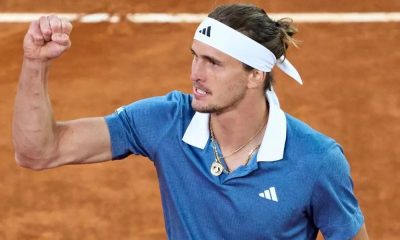
 ATP3 days ago
ATP3 days agoAlexander Zverev proves to be too consistent for a wavering Denis Shapovalov
-
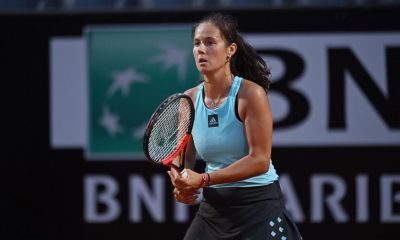
 Hot Topics2 days ago
Hot Topics2 days agoLGBT Players ‘Given Guarantees’ On Safety Of Playing In Saudi Arabia
-
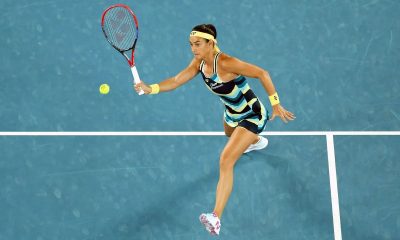
 Latest news2 days ago
Latest news2 days agoCaroline Garcia Criticises Two-Week Format At Madrid Open
-
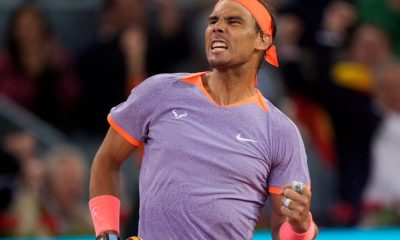
 Focus3 days ago
Focus3 days agoMadrid Open Daily Preview: Can Rafael Nadal Continue His Run?
-
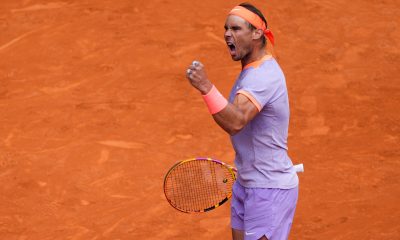
 Hot Topics2 days ago
Hot Topics2 days agoRafael Nadal Marks 22nd Anniversary Of Tour Debut With Rollercoaster Win In Madrid
-

 Focus2 days ago
Focus2 days agoMadrid Open Daily Preview: Rafael Nadal Faces Jiri Lehecka in the Fourth Round
-

 Hot Topics13 hours ago
Hot Topics13 hours agoRafael Nadal Says Goodbye To Madrid But Vows To Continue Farewell Tour
-

 Latest news1 day ago
Latest news1 day agoJannik Sinner rallies from one set down against Karen Khachanov to reach the quarter final in Madrid for the first time in his career

